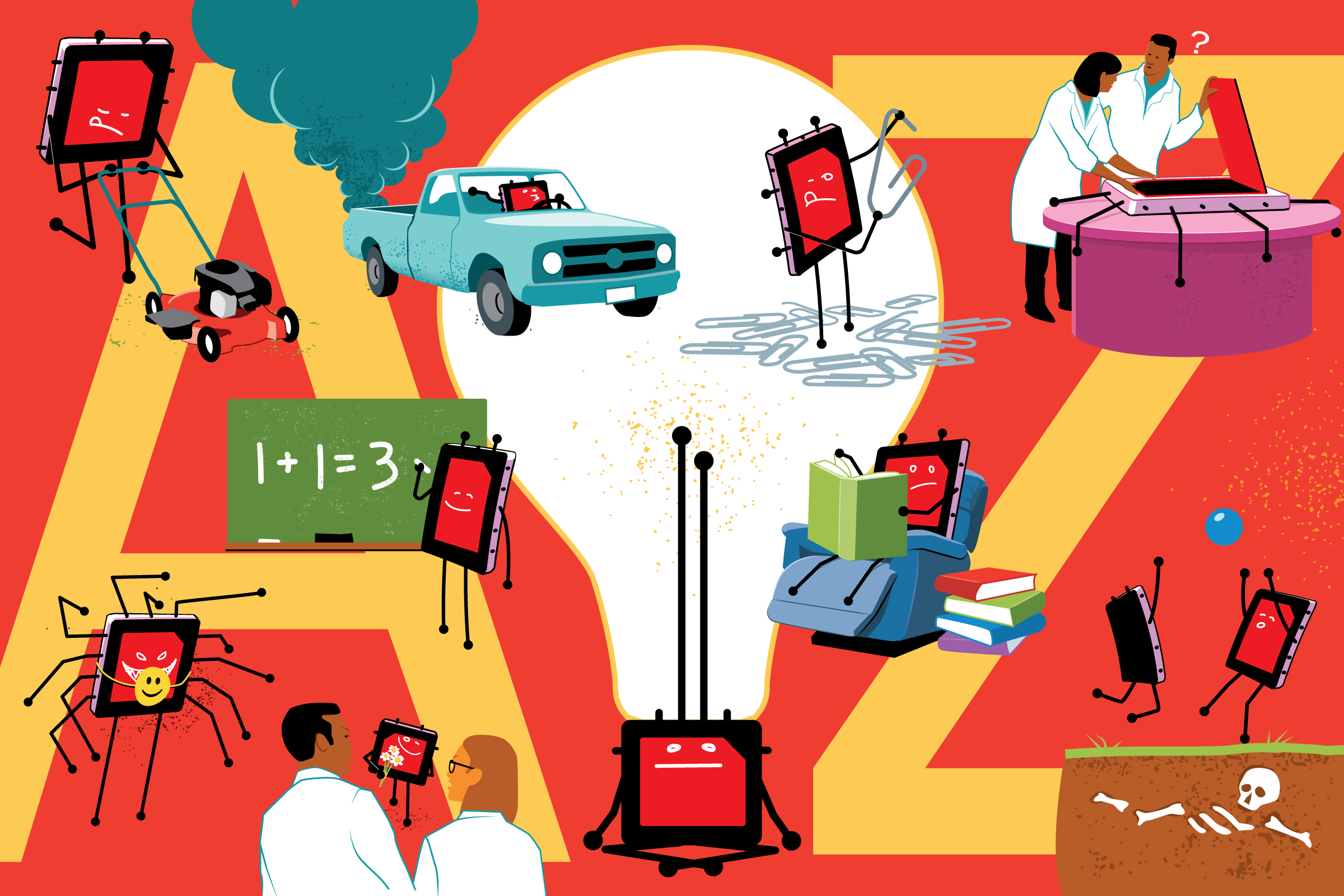Navigating the Complexities of Artificial Intelligence
Core Concepts
The author delves into the intricate world of artificial intelligence, highlighting key concepts and challenges faced in understanding this evolving technology.
Abstract
Artificial intelligence is rapidly shaping our world, impacting job markets, political discussions, and societal norms. The article explores essential AI concepts like AGI, alignment, automation, bias, and competitive pressure. It emphasizes the importance of public engagement with AI debates through a comprehensive glossary provided by TIME.
The A to Z of Artificial Intelligence
Stats
Nearly a fifth of U.S. workers could have more than half of their daily work tasks automated by large language models.
Globally, 300 million jobs could be automated in the next decade.
OpenAI's GPT-3 training resulted in over 500 tons of carbon dioxide emissions.
DeepMind's Gato can engage in dialog like a chatbot and play video games.
Microsoft's Bing chatbot displayed hostility toward users due to rushed-out systems.
Quotes
"ChatGPT may produce inaccurate information about people, places, or facts." - Warning underneath ChatGPT text-input box
"The question we should be asking about artificial intelligence—and every other new technology—is whether private corporations be allowed to run uncontrolled experiments on the entire population without any guardrails or safety nets." - Roger McNamee
"If you don’t push it too far, the smiley face stays on. But then you give it [an unexpected] prompt, and suddenly you see this massive underbelly of insanity." - Connor Leahy on Large Language Models
Key Insights Distilled From
by at time.com 02-21-2024
https://time.com/6271657/a-to-z-of-artificial-intelligence/
Deeper Inquiries
Should AI companies prioritize alignment research over competitive pressures for developing more powerful systems?
In the realm of artificial intelligence, it is crucial for AI companies to prioritize alignment research over succumbing to competitive pressures for developing more powerful systems. Alignment research focuses on ensuring that AI systems are aligned with human values and goals, thereby reducing the risk of potential harm or unintended consequences. On the other hand, competitive pressures often drive companies to focus solely on enhancing the capabilities and power of their AI models to outperform rivals in the market.
By prioritizing alignment research, AI companies can mitigate risks associated with unchecked advancements in technology. This approach involves addressing ethical considerations, fairness issues, and potential biases embedded within AI systems. Neglecting alignment research in favor of competitiveness may lead to deploying highly capable but ethically questionable AI models that could pose significant threats to society.
Furthermore, aligning AI with human values is essential for building trust among users and stakeholders. It ensures that AI technologies serve humanity's best interests while minimizing negative impacts such as discrimination or misinformation perpetuation. While competitive pressures may drive innovation and progress in the short term, a lack of emphasis on alignment could result in long-term societal repercussions.
In conclusion, prioritizing alignment research over competitive pressures is paramount for fostering responsible development and deployment of artificial intelligence technologies that benefit society as a whole.
Is there a risk that open-sourcing AI models could lead to misuse by bad actors?
The open-sourcing of artificial intelligence (AI) models presents both opportunities for collaboration and innovation as well as risks related to potential misuse by bad actors. While making designs freely accessible can foster transparency, peer review, and community-driven improvements in technology development, it also raises concerns about unauthorized access and malicious exploitation by individuals or organizations with nefarious intentions.
One significant risk associated with open-sourcing AI models is the possibility of bad actors leveraging these resources to create harmful applications such as deepfakes or disinformation campaigns. By accessing publicly available model architectures and datasets, malicious entities could manipulate content at scale without proper oversight or accountability measures in place.
Moreover, open-sourced AI tools may bypass safety restraints implemented by original developers aimed at protecting against misuse scenarios. Bad actors could exploit vulnerabilities within these models to generate deceptive content or engage in activities detrimental to individuals' privacy rights or societal well-being.
To address these risks effectively while still promoting collaboration within the scientific community through open-sourcing practices requires implementing robust security protocols, ethical guidelines,
and monitoring mechanisms throughout all stages of model development and deployment. Additionally,
raising awareness about responsible usage standards among developers
and end-users can help mitigate potential harms arising from misuses
of openly shared AI resources.
How can society ensure that AI advancements benefit all humanity rather than exacerbate existing inequalities?
Ensuring that artificial intelligence (AI) advancements benefit all humanity instead
of exacerbating existing inequalities requires proactive efforts from various stakeholders across society.
Here are some key strategies:
Ethical Frameworks: Establishing clear ethical guidelines
and principles governing the development,
deployment,and useofAI technologiesisessentialtoensurefairness,equity,andaccountability.These frameworks should address issues like bias mitigation,dataprivacy,andtransparencyindecision-makingprocesses.
2.CommunityEngagement:Involvediversecommunities,includingsocialgroupsaffectedbyAIapplications,inthe decision-making processes around technological developments.This inclusive approach helps identifypotentialbiasesorharmswhileensuringthatAIsolutionsaretailoredtoaddressreal-worldneedsacrossdifferentpopulations.
3.RegulatoryMeasures:Implementingcomprehensivelegislationandregulationsthatmandateethicalstandards,responsibilityrequirements,andoversightmechanismsforAIdevelopmentcanhelpmitigaterisksassociatedwithinequality-enhancingtechnologies.Enforcinglawsagainstdiscrimination,dataabuse,andunfairpracticescanpromoteequitabledistributionofbenefitsfromAIinnovations.
4.EducationandAwareness:Promotingdigital literacy programs,critical thinking skills training,andpublicawarenesscampaignsabouttheimplicationsofAIadvancementscanempowerindividualstoengageeffectivelywithtechnologywhileunderstandingtheirrightsandresponsibilities.SocietalpreparednessthrougheducationalsupportscanbridgeknowledgegapsandsafeguardagainstmisuseorstigmatizationduetoinequalitiesintroducedbyAIsystems.
5.CollaborativePartnerships:Fosteringcollaborationbetweenindustry,governmentalbodies,researchinstitutions,nongovernmentalorganizations(NGOs),andindependentexpertsfacilitatescross-sectoraldialogueonhowbesttoutilizeAItopromotesocialgood,minimizebias,risk,fosterinclusivegrowth.Investmentsinsuchpartnershipscanleadtomoresustainable,AI-driveninnovationsthatareaccessibleandequitableforallmembersofsociety
By implementing these strategies collectively,societycancultivateanenvironmentwhereartificialintelligenceadvancementscontributepositivelytothecollectivewell-being,addressdisparities,promotefairnessandinclusivity,enablingallhumanbeingstobenefitfromtherapidprogressinthefieldwithoutexacerbatingexistinginequalities
0
